

Compact Muon Solenoid
LHC, CERN
| CMS-EXO-20-008 ; CERN-EP-2022-037 | ||
| Search for narrow resonances in the b-tagged dijet mass spectrum in proton-proton collisions at $\sqrt{s} = $ 13 TeV | ||
| CMS Collaboration | ||
| 4 May 2022 | ||
| Phys. Rev. D 108 (2023) 012009 | ||
| Abstract: A search is performed for narrow resonances decaying to final states of two jets, with at least one jet originating from a b quark, in proton-proton collisions at $\sqrt{s} = $ 13 TeV. The data set corresponds to an integrated luminosity of 138 fb$^{-1}$ collected with the CMS detector at the LHC. Jets originating from energetic b hadrons are identified through a b tagging algorithm that utilizes a deep neural network or the presence of a muon inside a jet. The invariant mass spectrum of jet pairs is well described by a smooth parametrization and no evidence for the production of new particles is observed. Upper limits on the production cross section are set for excited b quarks and other resonances decaying to dijet final states containing b quarks. These limits exclude at 95% confidence level models of Z' bosons with masses from 1.8 to 2.4 TeV and of excited b quarks with masses from 1.8 to 4.0 TeV. This is the most stringent exclusion of excited b quarks to date. | ||
| Links: e-print arXiv:2205.01835 [hep-ex] (PDF) ; CDS record ; inSPIRE record ; CADI line (restricted) ; | ||
| Figures | |
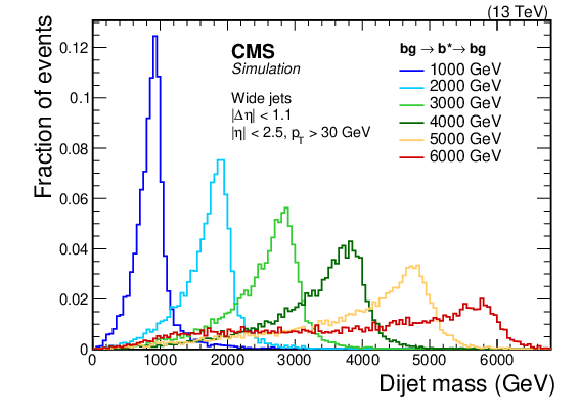
png pdf |
Figure 1:
Simulated signal shapes of b* from the process $\mathrm{b} \mathrm{g} \to {\mathrm{b} ^{\ast}} \to \mathrm{b} \mathrm{g} $. Shown are the wide jets (see text) used to reconstruct the dijet mass spectra. |
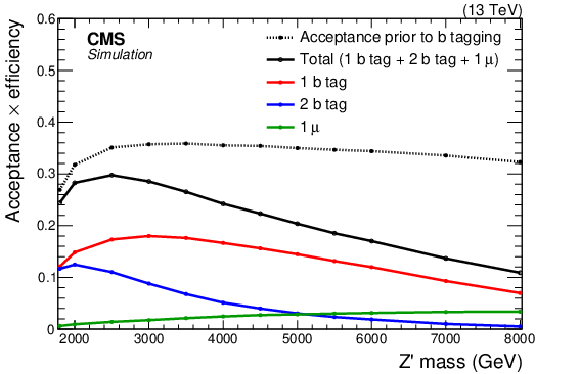
png pdf |
Figure 2:
The product of acceptance and efficiency of the event selection for a $\mathrm{Z'} \to \mathrm{b} {}\mathrm{\bar{b}} $ resonance as a function of the resonance mass. |
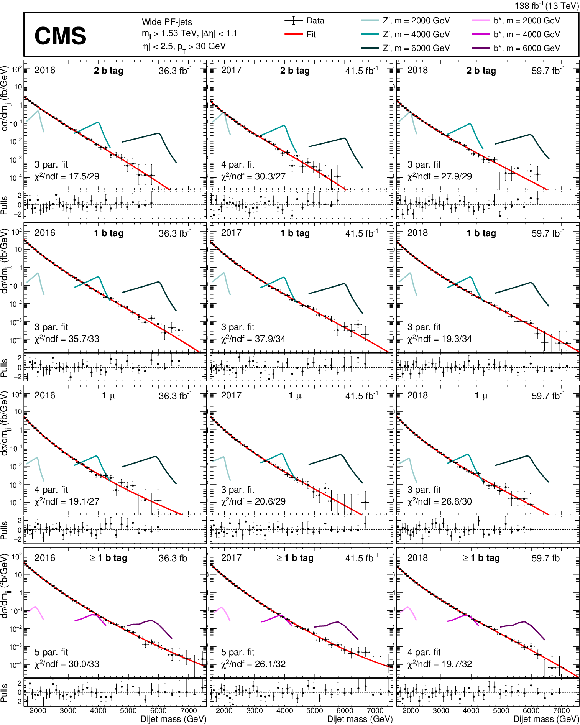
png pdf |
Figure 3:
The observed differential cross sections as a function of the dijet mass, shown as fit with the background functions, for the four tagging categories (rows) and the three data-taking periods (columns). The number of parameters in the fit, and the goodness of fit "$\chi ^2/\text {ndf}$'', are listed where "ndf'' is the number of degrees of freedom. The lower panel within each row shows the pulls, $(\text {data}-\text {fit})/\text {uncertainty}$, in units of the statistical uncertainty in data. The upper three rows are used to search for Z' models, the bottom row is used to search for the b* model, and example shapes of these signal models are shown with the same arbitrary normalization for three choices of resonance mass. |

png pdf |
Figure 4:
The observed 95% CL upper limits (solid curve) on the product of the cross section and branching fraction (left), and multiplied by signal acceptance (right), for a resonance decaying to $\mathrm{b} {}\mathrm{\bar{b}}$. The corresponding expected limits (dashed curve) and their variations at the 1- and 2-standard deviation levels (shaded bands) are also shown. Limits are compared to predicted cross sections for Z' bosons from the sequential SM (SSM) and the heavy vector triplet (HVT) models A and B. The latter two models follow the parameter choices of $ {g_\text {V}} =$ 1 and $ {g_\text {V}} =$ 3 respectively. |

png pdf |
Figure 4-a:
The observed 95% CL upper limits (solid curve) on the product of the cross section and branching fraction for a resonance decaying to $\mathrm{b} {}\mathrm{\bar{b}}$. The corresponding expected limits (dashed curve) and their variations at the 1- and 2-standard deviation levels (shaded bands) are also shown. Limits are compared to predicted cross sections for Z' bosons from the sequential SM (SSM) and the heavy vector triplet (HVT) models A and B. The latter two models follow the parameter choices of $ {g_\text {V}} =$ 1 and $ {g_\text {V}} =$ 3 respectively. |
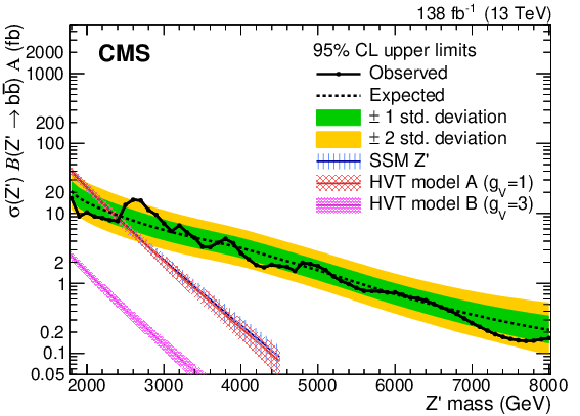
png pdf |
Figure 4-b:
The observed 95% CL upper limits (solid curve) on the product of the cross section and branching fraction multiplied by signal acceptance, for a resonance decaying to $\mathrm{b} {}\mathrm{\bar{b}}$. The corresponding expected limits (dashed curve) and their variations at the 1- and 2-standard deviation levels (shaded bands) are also shown. Limits are compared to predicted cross sections for Z' bosons from the sequential SM (SSM) and the heavy vector triplet (HVT) models A and B. The latter two models follow the parameter choices of $ {g_\text {V}} =$ 1 and $ {g_\text {V}} =$ 3 respectively. |

png pdf |
Figure 5:
The coupling strengths to SM bosons (${g_\text {H}}$) and fermions (${g_\text {F}}$) of a Z' boson with mass 2.0 TeV (blue) and 2.5 TeV (red) that are excluded at 95% CL for the HVT model. The shading indicates the excluded side of the contour. The benchmark scenarios corresponding to HVT models A and B are represented by a purple cross and a red point, respectively. The gray shaded area corresponds to the region where the resonance natural width is predicted to be larger than the typical experimental resolution, and thus the narrow-width approximation is not fulfilled. |
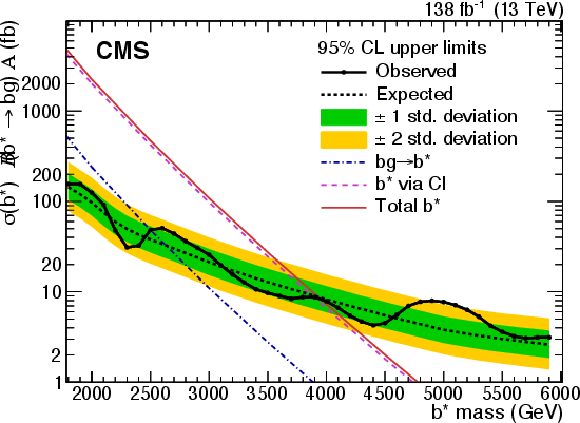
png pdf |
Figure 6:
The observed 95% CL upper limits on the product of the cross section, branching fraction, and acceptance for dijet resonances decaying to a b quark and a gluon (points). The corresponding expected limits (short dashed) and their variations at the 1- and 2-standard deviation levels (shaded bands) are also shown. Limits are compared to predictions for single b* production (blue, dot dashed), the resonant component of the b* production via contact interactions (magenta, long dashed), and the total b* signal from the sum of these two production modes (red, solid). |
| Summary |
| A search for heavy resonances decaying into b quarks has been presented and no excess has been found over the standard model (SM) expectations. The data were collected by the CMS experiment at $\sqrt{s} = $ 13 TeV during 2016-2018 and correspond to an integrated luminosity of 138 fb$^{-1}$. Model-independent upper limits are set on the product of the cross section of the resonance and its branching fraction to b quarks. Signals of Z' bosons decaying to pairs of b quarks are considered, for both the previously explored sequential standard model (SSM), and also for a new heavy vector triplet (HVT) model. The decays of Z' bosons in both the SSM and the HVT Model A are excluded at 95% confidence level for masses from 1.8 to 2.4 TeV, and limits are set on the coupling strengths of the HVT boson to SM bosons and fermions. Signals of an excited b quark are considered for a previously explored channel, $\mathrm{b}\mathrm{g}\to{\mathrm{b}^{\ast}} \to\mathrm{b}\mathrm{g}$, and a production mode via contact interactions. The excited b quark is excluded at 95% confidence level for masses from 1.8 to 4.0 TeV. This is the most stringent exclusion of excited b quarks to date. |
| References | ||||
| 1 | CMS Collaboration | Precise determination of the mass of the Higgs boson and tests of compatibility of its couplings with the standard model predictions using proton collisions at 7 and 8 TeV | EPJC 75 (2015) 212 | CMS-HIG-14-009 1412.8662 |
| 2 | ATLAS Collaboration | Measurement of the Higgs boson mass from the $ H\rightarrow{}\gamma{}\gamma{} $ and $ H\rightarrow{}Z{Z}^{*}\rightarrow{}4\ell{} $ channels in $ pp $ collisions at center-of-mass energies of 7 and 8~TeV with the ATLAS detector | PRD 90 (2014) 052004 | 1406.3827 |
| 3 | ATLAS Collaboration | Evidence for the spin-0 nature of the Higgs boson using ATLAS data | PLB 726 (2013) 120 | 1307.1432 |
| 4 | CMS and ATLAS Collaborations | Combined measurement of the Higgs boson mass in $ pp $ collisions at $ \sqrt{s}= $ 7 and 8 TeV with the ATLAS and CMS experiments | PRL 114 (2015) 191803 | 1503.07589 |
| 5 | V. D. Barger, W.-Y. Keung, and E. Ma | A gauge model with light $ W $ and $ Z $ bosons | PRD 22 (1980) 727 | |
| 6 | E. Salvioni, G. Villadoro, and F. Zwirner | Minimal Z' models: present bounds and early LHC reach | JHEP 09 (2009) 068 | 0909.1320 |
| 7 | P. Langacker | The physics of heavy Z' gauge bosons | Rev. Mod. Phys. 81 (2009) 1199 | 0801.1345 |
| 8 | D. Pappadopulo, A. Thamm, R. Torre, and A. Wulzer | Heavy vector triplets: bridging theory and data | JHEP 09 (2014) 60 | 1402.4431 |
| 9 | H. Terazawa, M. Yasu\`e, K. Akama, and M. Hayashi | Observable effects of the possible sub-structure of leptons and quarks | PLB 112 (1982) 387 | |
| 10 | E. Eichten and M. Peskin | New tests for quark and lepton substructure | PRL 50 (1983) 811 | |
| 11 | H. Harari | Composite models for quarks and leptons | Phys. Rep. 104 (1984) 159 | |
| 12 | U. Baur, I. Hinchliffe, and D. Zeppenfeld | Excited Quark Production at Hadron Colliders | Int. J. Mod. Phys. A 2 (1987) 1285 | |
| 13 | U. Baur, M. Spira, and P. M. Zerwas | Excited quark and lepton production at hadron colliders | PRD 42 (1990) 815 | |
| 14 | R. M. Harris and K. Kousouris | Searches for Dijet Resonances at Hadron Colliders | Int. J. Mod. Phys. A 26 (2011) 5005 | 1110.5302 |
| 15 | CMS Collaboration | Search for narrow resonances and quantum black holes in inclusive and b-tagged dijet mass spectra from pp collisions at $ \sqrt{s} = $ 7 TeV | JHEP 01 (2013) 013 | CMS-EXO-11-094 1210.2387 |
| 16 | CMS Collaboration | Search for resonances and quantum black holes using dijet mass spectra in proton-proton collisions at $ \sqrt{s}=8\text{}\text{}\mathrm{TeV} $ | PRD 91 (2015) 052009 | CMS-EXO-12-059 1501.04198 |
| 17 | CMS Collaboration | Search for narrow resonances in the b-tagged dijet mass spectrum in proton-proton collisions at $ \sqrt{s} = $ 8 TeV | PRL 120 (2018) 201801 | CMS-EXO-16-057 1802.06149 |
| 18 | CMS Collaboration | Search for high mass dijet resonances with a new background prediction method in proton-proton collisions at $ \sqrt{s} = $ 13 TeV | JHEP 05 (2020) 033 | CMS-EXO-19-012 1911.03947 |
| 19 | ATLAS Collaboration | Search for new resonances in mass distributions of jet pairs using 139 fb$ ^{-1} $ of $ pp $ collisions at $ \sqrt{s}= $ 13 TeV with the ATLAS detector | JHEP 03 (2020) 145 | 1910.08447 |
| 20 | G. Ciezarek et al. | A Challenge to Lepton Universality in B Meson Decays | Nature 546 (2017) 227 | 1703.01766 |
| 21 | LHCb Collaboration | Test of lepton universality in beauty-quark decays | NP 18 (2022) 277 | 2103.11769 |
| 22 | CMS Collaboration | HEPData record for this analysis | link | |
| 23 | CMS Collaboration | The CMS experiment at the CERN LHC | JINST 3 (2008) S08004 | CMS-00-001 |
| 24 | CMS Collaboration | Description and performance of track and primary-vertex reconstruction with the CMS tracker | JINST 9 (2014) P10009 | CMS-TRK-11-001 1405.6569 |
| 25 | CMS Collaboration | Performance of the CMS Level-1 trigger in proton-proton collisions at $ \sqrt{s} = $ 13 TeV | JINST 15 (2020) P10017 | CMS-TRG-17-001 2006.10165 |
| 26 | CMS Collaboration | The CMS trigger system | JINST 12 (2017) P01020 | CMS-TRG-12-001 1609.02366 |
| 27 | J. Alwall et al. | The automated computation of tree-level and next-to-leading order differential cross sections, and their matching to parton shower simulations | JHEP 07 (2014) 079 | 1405.0301 |
| 28 | T. Sjostrand et al. | An introduction to PYTHIA 8.2 | CPC 191 (2015) 159 | 1410.3012 |
| 29 | P. Skands, S. Carrazza, and J. Rojo | Tuning PYTHIA 8.1: the Monash 2013 Tune | EPJC 74 (2014) 3024 | 1404.5630 |
| 30 | CMS Collaboration | Event generator tunes obtained from underlying event and multiparton scattering measurements | EPJC 76 (2016) 155 | CMS-GEN-14-001 1512.00815 |
| 31 | R. D. Ball et al. | Parton distributions with QED corrections | NPB 877 (2013) 290 | 1308.0598 |
| 32 | R. D. Ball et al. | Unbiased global determination of parton distributions and their uncertainties at NNLO and at LO | NPB 855 (2012) 153 | 1107.2652 |
| 33 | GEANT4 Collaboration | GEANT4--a simulation toolkit | NIMA 506 (2003) 250 | |
| 34 | CMS Collaboration | Particle-flow reconstruction and global event description with the CMS detector | JINST 12 (2017) P10003 | CMS-PRF-14-001 1706.04965 |
| 35 | CMS Collaboration | Pileup mitigation at CMS in 13 TeV data | JINST 15 (2020) P09018 | CMS-JME-18-001 2003.00503 |
| 36 | M. Cacciari, G. P. Salam, and G. Soyez | The anti-$ {k_{\mathrm{T}}} $ jet clustering algorithm | JHEP 04 (2008) 063 | 0802.1189 |
| 37 | M. Cacciari, G. P. Salam, and G. Soyez | FastJet user manual | EPJC 72 (2012) 1896 | 1111.6097 |
| 38 | M. Cacciari, G. P. Salam, and G. Soyez | The catchment area of jets | JHEP 04 (2008) 005 | 0802.1188 |
| 39 | CMS Collaboration | Jet energy scale and resolution in the CMS experiment in pp collisions at 8 TeV | JINST 12 (2017) P02014 | CMS-JME-13-004 1607.03663 |
| 40 | CMS Collaboration | Jet algorithms performance in 13 TeV data | CMS-PAS-JME-16-003 | CMS-PAS-JME-16-003 |
| 41 | E. Bols et al. | Jet Flavour Classification Using DeepJet | JINST 15 (2020) P12012 | 2008.10519 |
| 42 | CMS Collaboration | Performance of the DeepJet b tagging algorithm using 41.9/fb of data from proton-proton collisions at 13 TeV with Phase 1 CMS detector | CDS | |
| 43 | M. H. Kutner, C. J. Nachtsheim, J. Neter, and W. Li | Applied linear statistical models | Irwin, 1996 Fifth edition. ISBN 9780256117363 | |
| 44 | M. J. Oreglia | A study of the reactions $\psi' \to \gamma\gamma \psi$ | PhD thesis, Stanford University, 1980 SLAC Report SLAC-R-236, see Appendix D | |
| 45 | CMS Collaboration | Identification of heavy-flavour jets with the CMS detector in pp collisions at 13 TeV | JINST 13 (2018) P05011 | CMS-BTV-16-002 1712.07158 |
| 46 | CMS Collaboration | Precision luminosity measurement in proton-proton collisions at $ \sqrt{s} = $ 13 TeV in 2015 and 2016 at CMS | EPJC 81 (2021) 800 | CMS-LUM-17-003 2104.01927 |
| 47 | CMS Collaboration | CMS luminosity measurement for the 2017 data-taking period at $ \sqrt{s} = $ 13 TeV | ||
| 48 | CMS Collaboration | CMS luminosity measurement for the 2018 data-taking period at $ \sqrt{s} = $ 13 TeV | ||
| 49 | J. Butterworth et al. | PDF4LHC recommendations for LHC Run II | JPG 43 (2016) 23001 | 1510.03865 |
| 50 | CMS and ATLAS Collaborations | Procedure for the LHC Higgs boson search combination in Summer 2011 | CMS-NOTE-2011-005 | |
| 51 | CMS Collaboration | Combination of CMS searches for heavy resonances decaying to pairs of bosons or leptons | PLB 798 (2019) 134952 | CMS-B2G-18-006 1906.00057 |
| 52 | T. Junk | Confidence level computation for combining searches with small statistics | NIMA 434 (1999) 435 | hep-ex/9902006 |
| 53 | A. L. Read | Presentation of search results: the CL$ _{\mathrm{s}} $ technique | JPG 28 (2002) 2693 | |
| 54 | G. Cowan, K. Cranmer, E. Gross, and O. Vitells | Asymptotic formulae for likelihood-based tests of new physics | EPJC 71 (2011) 1554 | 1007.1727 |

|
Compact Muon Solenoid LHC, CERN |

|

|

|

|

|

|